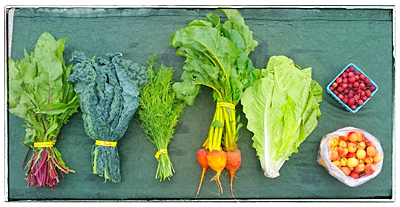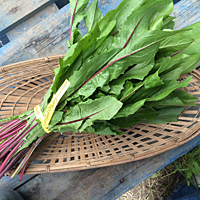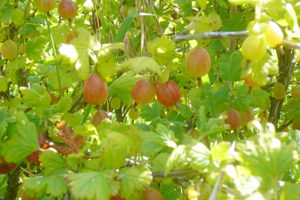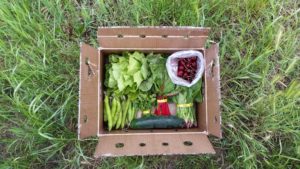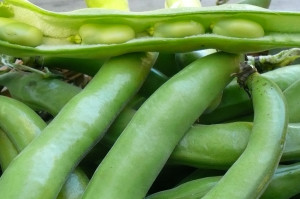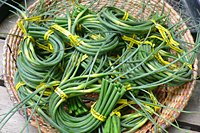In the Standard Box:
Red Beets with Greens 1 bu
Red Dandelion Greens 1 bu
Rainier Cherries* 1.5 lb
Gooseberries 1/2 pt
Spinach 2 bu
Rainbow Chard 1 bu
Basil 1/4 lb
Red Butter Lettuce 2 hds
Baby Dill 1 bu
In the Small Box:
Golden Beets with Greens 1 bu
Red Dandelion Greens 1 bu
Rainier Cherries* 1.5 lb
Gooseberries 1/2 pt
Lacinato Kale 1 bu
Romaine Lettuce (Red Dog Farm) 1 hd
Baby Dill 1 bu
Red Dandelion Greens
Red Dandelion greens (above) are not dandelions at all, but members of the Chicory family. These antioxidant-rich greens are an excellent source of vitamins A, C and K, as well as iron, calcium, and omega-3 and omega-6 fatty acids.
Red Dandelion greens have a slightly bitter, peppery taste, so if you eat them raw in a salad, toss them with your lettuce, as you would with radicchio. Wilt them into pasta dishes with a strong cheese like Parmesan or Pecorino, or add to hearty soups. They don’t wilt down too much, like spinach.
As a vegetable side, braised Red Dandelions are especially delicious with bacon or pancetta. Other complimentary flavors include anchovies, ham, egg, legumes, soy sauce, vinegar, mustard, lemon, onion, garlic, chili, nuts and sesame. A classic French raw dandelion salad incorporates bacon, croutons, hard-boiled eggs and a Dijon dressing. Mix them into cold grain salads (like Nash’s whole grains or wild rice). They can be sautéed or stir-fried just like other greens. They maintain their flavor well.
Gooseberries
Gooseberries are from the same botanical family as currants, and grow wild and prolific in places like North America and Siberia. They have numerous health beneficial effects against cancer, aging, inflammation, and neurological diseases. Rich in antioxidants and vitamins, the fiber content constitutes 26 percent of the daily recommended value.
1/4 cup plus 1 Tbsp. butter, divided
1-1/3 cups sugar, divided
3/4 cup Nash’s soft white wheat flour
1 tsp. baking powder
1/2 cup milk
1 cup gooseberries
1 cup boiling water
In a large bowl, combine 1/4 cup butter and 1/3 cup sugar; blend well. In a separate bowl, combine flour and baking powder; mix well. Add flour mixture and milk alternately to butter mixture; stir well.
Spread batter in a well-greased 8″ round cake pan; top with gooseberries. Sprinkle remaining sugar over berries and dot with remaining butter. Pour boiling water over all; do not stir. Bake at 375 degrees for 30 to 40 minutes. Serves 10.
Fresh Dill
 Dill is a delicious addition to your pickled veggies, salad dressings, and fish dishes. It has bioactive compounds (also called phytonutrients, or plant chemicals) that help to protect our cells from cancer by protecting them from carcinogenic compounds in our environment.
Dill is a delicious addition to your pickled veggies, salad dressings, and fish dishes. It has bioactive compounds (also called phytonutrients, or plant chemicals) that help to protect our cells from cancer by protecting them from carcinogenic compounds in our environment.
Throw some extra dill into your side dishes (a must in potato salads) on these warm summer evenings. Dill has similar compounds to garlic that offer anti-bacterial properties, so it can also help to prevent bacterial overgrowth. This unassuming, but powerful herb also offers us important minerals, such as calcium, manganese, iron, and magnesium.
Pickled Eggs with Dill
12 large eggs 1 red onion, sliced
Small bundle of fresh dill ½ tsp. mustard seeds
1 clove garlic, halved 1 ¼ cup cider vinegar
¾ cup water 2 tsp. salt
Fill a large saucepan with water (enough to cover dozen eggs). Bring the water to a simmer (not a boil!) and then gently add in the eggs by lowering them in with a spoon, one by one. Set your timer to 12 minutes and allow eggs to simmer. Turn off heat, remove the eggs from the pot, and run under cold water. You can gently pour the pot of eggs through a metal strainer and then run cold water over them. Peel the eggs once cool enough to handle.
In a medium saucepan over medium-high heat, bring all other ingredients to a boil. Reduce heat to medium-low and allow to simmer for 5 to 7 minutes.
Pour mixture into a large jar (or two smaller jars), and add the hard-boiled eggs and allow to cool for several minutes, then refrigerate. Your eggs will need anywhere from 2 to 3 weeks to pickle. Once ready though, they will stay good for quite a long time. Serve on a bed of spinach greens or eat as a snack.
Recipe adapted by Virginia Newman from: http://paleoleap.com


